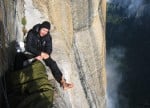A very good description of this route is available on Mountain Project. To update this, I would mention that anchors on the lower half of the route have been replaced, the 'Legitimately Exciting' pitch after the first three 5.13s is now pretty reasonable (E3?) thanks to some fixed beaks, there's been a hold break making La Niña a touch harder, the alternative stance in the Black Dihedral isn't obvious (but would be convenient) and there seems to be some alternative options for the exit pitches, depending on your rope lengths (other routes might criss cross or merge here).
Starting off the footstool at the base of North America Wall, three 5.13 pitches lead to an easier line of interesting pitches leading to the Big Sur ledge. The first and third of these 5.13s, The Black Dike and Galapagos, represent a particular barrier to entry for the wall, with good conditions lasting for only a couple of hours each day. These pitches are of very high quality, although the first pitch has a particularly runout crux (despite Honnold placing an extra bolt here I think). Before Big Sur are the Calaveras Ledges, which are about 80m long and need to be traversed in stages with haul bags (perhaps a lower-out then a shuffle). Big Sur can happily accommodate two teams with ledges and bags.
Following Big Sur is the Pineapple Express variation, starting with La Niña – a long and impressive pitch consisting of some endurance climbing followed by a crimpy boulder. This was given .13b/c, and considered the crux, but it sounds like a hold has broken and it might be considered .13c now, but it's not much harder than the opening pitches. There are two particularly loose holds following the crux, so take care. Getting conditions for this is perhaps the crux (early morning is best, or headtorches at night) and the boulder crux really eats skin, so spend your skin wisely.
After two more engaging 5.12 pitches, the route rejoins the original at the Black Dihedral – an exciting and adventurous pitch with some loose rock in places. These 5.12s feel like three tricky E5 pitches from La Niña to gain Rotten Island, a belay below the Black roof surrounded by loose flakes.
Gaining the Black Roof is your exit from the flaky diorite of the North America feature and requires a tricky traversing boulder out of the roof onto the headwall. The rock in the roof is imperfect but not dangerous. The position is fantastic.
After the Black Roof is a wandering pitch which has been erroneously described as 5.11a and perhaps feels like runout E3/4. A runout from the belay out left passes a broken peg to reach an easy flake line up, then hard right to a tricky move into a right facing corner. Following this is the Slalom pitch, which can start with a downclimb or moves directly right from the belay, then wanders around interesting and enjoyable face climbing and passes a roof to reach the Cyclops Eye.
The Cyclops Eye is the second good, commodious ledge for a bivi or portaledge, even more spacious than Big Sur. From the right end of the ledge an .11a with one hard move reaches a .12c with an interesting downward mantel to sloper campus moves. The Dolphin Chimney that follows is one of the best pitches of the route, and one to savour at .12b. This pitch would be good anywhere. A 60m haul line just about reaches from the RH end of Cyclops Eye to here. An easier but still interesting 15m .12a (or perhaps .11a) leads to another belay above and to the left.
The original route went direct up the 'Eismeer' pitch up and right, and would be the best way to go if it wasn't for a hold break. We were reliably informed the boulder was just too hard (something like .14a) compared to the Lucy is a Labrador variation on the left, even when Lucy is wet (which is after any decent rainfall is seems). The leftward traverse of Lucy is well protected, but not set up well for free climbing. The second bolt needs replacing. It's possible to climb this wet, but obviously harder. A sock stuck into the first wet hold and some tin foil/wind can help.
Following this (if taking the Lucy variation) you need to make a 'C' shape by climbing leftwards, upwards at .11a and then an easy 5.9 to reach the top of The Igloo (possible bivi if necessary). A 70m rope would make it, then another short pitch traversing right and up to find a belay will bring you to a good hauling point from Lucy (with 60m haul line and enough line for a 15m lower-out). There's more than one option for this, as there are bolts and belays smattered about here, some are easier to find than others. A couple of easier pitches then leads to the top.
There's a fair bit of info online for this route now, try looking a different typos as the updates can be helpful. It's a fantastic route despite the poorer rock quality compared with the southwest face, and a different (more facey, less cracky) style of climbing.
Feedback
There is no feedback for this climb.
Logged Ascents
Guidebooks for El Capitan
Not all climbs at crag may appear in this bookPlease Login to view more details on the logged ascents
Salathe Wall
Grade: 5.13c ***
(El Capitan)

